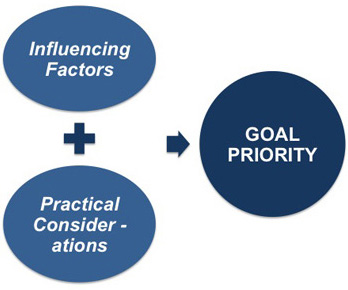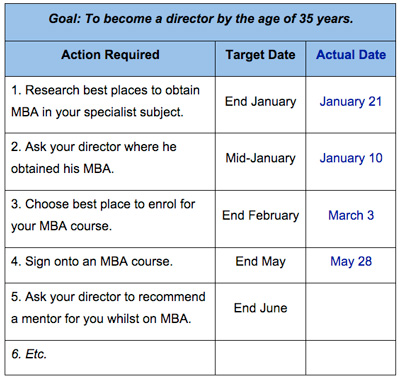Prioritizing Your Personal Goals
If you have only one goal you need to achieve to successfully realize your aspiration then life is simple.
 |
However, for most people, there will be several different aspirations, which cover each aspect of their life. Some examples could be:
• Career - become a director by 35 years old.
• Academic - attain an MBA.
• Personal - become fit or lose weight.
• Relationship - find a partner or start a family.
• Leisure - visit Australia or go on a cruise.
• Financial - pay off car loan or mortgage.
It is unrealistic to expect to be able to achieve all of these simultaneously, so it is fundamental to decide which aspirations are the main priorities. Some of your aspirations may be linked to each other (e.g. you may want to become a director but know this will be accomplished much more easily if you have an MBA), or they could conflict with one another (e.g. you can't go to Australia this year because of your car loan payments).
 |
To be able to turn these aspirations into goals using one of the above methods, you will have to assign a hierarchy to them. This ranking enables you to work effectively and rationally in attaining those goals that are most important and aid in you completing others.
Each person's individual circumstances will influence how they prioritize their goals.
As you work through the process of putting your goals into a hierarchy you will take into account the practicalities you face in attaining each goal. You will also look at how many factors that may be influencing your successful attainment of a goal are within your own control.
As you weigh each goal against these two categories you will develop a ranking for each goal. By working through all your goals in this fashion, the resulting list will provide you with your goal priorities.
When you arrive at your list of goals ranked by the order of importance, you then have to determine whether there are too many. It is important to remember that having too many goals can become distracting, and is often unrealistic.
By concentrating your effort on the goals that are the most achievable within your set timescales, and for which there are available resources, you will be able to focus on the correct number of goals that enable you to work effectively. It is important to inform others of your intent, which can then help prevent interruptions.
Finally, by listing the actions required to meet your goal, you will be provided with an action plan. This plan may look something like the example below and will help you to monitor and review your progress, whilst highlighting where it may be necessary to make amendments. There are three commonly used methods of setting goals. These are the 4CF Method, the SMART Method and the Backwards Goal Setting Method.
So, for example, your action plan to 'become a director by the age of 35 years,' could look something like this table:
 |
Using the following assumptions that:
• You are 28 years old.
• You have a first class degree.
• You know your director plans to retire in 4 years.
• You know he hasn't yet chosen his replacement.
• Today is June 2.
Your action plan then shows that your planning has proven to be almost 100% accurate so far, with all but one of your deadlines being achieved ahead of your set date. The only action you were late on was Action 3, which although three days late, has not impacted any of the subsequent actions. You also know the reason for this delay was, for example, the fact that you had flu, and so was a circumstance out of your control.
This is a very simplistic example but illustrates how this visual reminder of your goal and actions maintains your focus and motivation effectively, so that you will attain your MBA. It would also quickly show you any problems that may arise, that could potentially distract you from attaining your goal and would therefore allow you to ask for the cooperation of colleagues or friends to help prevent these issues from arising.
Finally, remember that by setting yourself goals, you will work more effectively and be motivated towards achieving them. Having a goal will also help you to focus your efforts on what is relevant and productive, whilst avoiding unnecessary distraction.
You may also be interested in:
Goal Setting for Managers | Goal Setting Theories of Locke and Latham | 4CF Goal Setting | SMART Goal Setting for Managers | Backwards Goal Setting.


